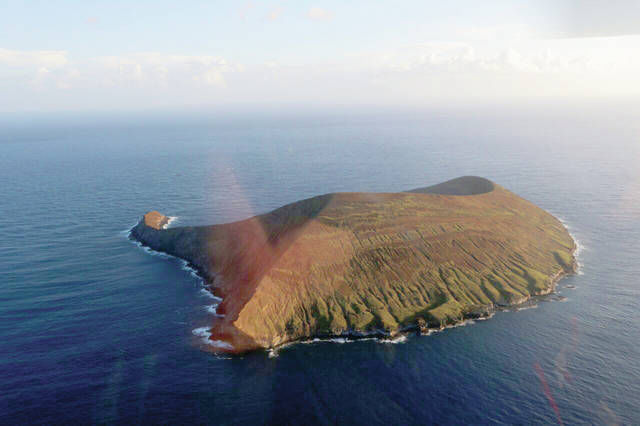LIHUE — Days from the first potential drop of 10 tons of rodenticide on Lehua Island, some are still demanding the state respond to unanswered questions. Meanwhile, the state Division of Forestry and Wildlife has set up a small worksite
LIHUE — Days from the first potential drop of 10 tons of rodenticide on Lehua Island, some are still demanding the state respond to unanswered questions.
Meanwhile, the state Division of Forestry and Wildlife has set up a small worksite on the island to collect environmental monitoring samples and says the project shouldn’t cause negative impacts.
“DOFAW still stands by its final environmental assessment and finding of no significant impact,” DOFAW representatives said in a statement to TGI.
But, Rep. Dee Morikawa isn’t satisfied with the answers from the state. She says she wants a response from the Department of Land and Natural Resources’ or the Department of Agriculture about the project before their first drop date, tentatively set for Wednesday.
“Questions about the project by many of my constituents — including environmentalists, fishers, tour boat operators and others — have not been answered,” Morikawa said in an Aug. 2 letter.
Addressed to Suzanne Case, chairwoman of DLNR and Scott Enright, chairman of the Hawaii Department of Agriculture, Morikawa details concerns about the plan to blanket the 284-acre island with rodenticide to kill invasive rats.
“I am asking you to please delay the rat eradication project until all concerns from the public have been addressed, and an agreement is reached on how best to proceed,” Moirkawa wrote.
Morikawa requests a response from DLNR and DOA by Tuesday so “I may inform my constituents on state cooperation for this project which directly affects their lives and livelihood.”
The effect of dropping the poison from helicopters during hurricane season was one of Morikawa’s concerns. She also questions the possible effects of the poison on coral reef, endangered monk seals, green sea turtles and fish that surround the island.
She pointed out one of the rodenticides under consideration is brodifacoum, which is not licensed for use in Hawaii.
“How is it possible to have our pesticide section authorize use of this?” she asked in the letter.
The other rodenticide under consideration for use is diphacinone.
Morikawa isn’t the only person questioning the state’s plan to drop rodenticide pellets over three days this month — tentatively on Aug. 8, Aug. 18 and Aug. 29, pending the approval of final permits.
Dropping diphacinone from helicopters over the island has also drawn concern from Robert Boesch, former head of DOA Pesticides Branch.
He touts concerns about impacts to the food chain and subsequent issues — like potential interactions with blood thinner medications in surrounding human populations — that he says need more study.
“I used to manage that program, and I was the one that wouldn’t issue any more permits unless they did good marine studies,” he said. “They didn’t. They did shoddy work.”
The potential for the poison to contaminate the ocean is another of Boesh’s concerns.
“I’m for bait stations, not for aerial (application),” Boesh said. “It’s going to end up in the marine environment and then eaten by the fish, and then the predator fish will consume it and it’ll move right up the food chain.”
Boesh was one of the people who did follow-up work after the 2009 Lehua poison drop, which has been dubbed a disaster by community members.
Keith Robinson, environmental officer of Niihau Ranch, said the 2009 attempt was a “frightfully mismanaged mess,” but it nearly worked.
And he’s optimistic about the success of this year’s attempt at rat eradication.
“This time around, the project in my opinion, is being far more intelligently managed than that helter skelter 2009 affair,” Robinson said in a letter to TGI. “It may just possibly succeed.”
HDOA’s plant industry division administrator, John McHugh, responded to Boesh’s concerns in a July 31 letter, saying HDOA will conduct an investigation of DITRAC D-50 PELLETS, which contain diphacinone because of Boesh’s request.
HDOA representatives were off-island and were unable to respond to questions from TGI on Thursday regarding McHugh’s letter or Beosh’s request for further research.
According to McHugh’s letter, if the investigation turns up any “unreasonable adverse effects to humans or the environment” that have, or could occur, HDOA will evaluate the pellets. If that conclusion is drawn, HDOA could cancel the pesticide use license.
A hearing would be required before HDOA cancels any pesticide licenses.
Representatives from DLNR pointed out the bait product HDOA is investigating does contain the same active ingredient, but has different inert ingredients.
“This appears to be a routine response to a request from the public to evaluate a pesticide product,” DOFAW representatives said in a statement to TGI.
But, HDOA is one of two entities standing in the way of the project because their aerial application permit is pending.
DOFAW and partners are also waiting on a National Oceanic and Atmospheric Administration Section 7 concurrence letter to proceed.
“If they (HDOA) don’t issue the permit, they (DOFAW and partners) can’t do the drop,” Morikawa said.
In her letter to Case and Enright, Morikawa pointed out that answering questions is part of the state’s responsibility.
“Please do not make the mistake of putting the project deadline ahead of informing the public on this sensitive endeavor,” she said. “If DOA doesn’t even have their concerns addressed, I can’t imagine that this project can go.”


